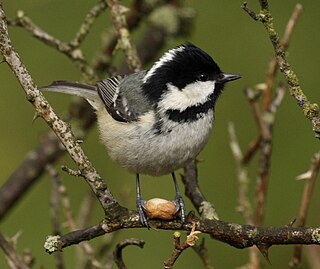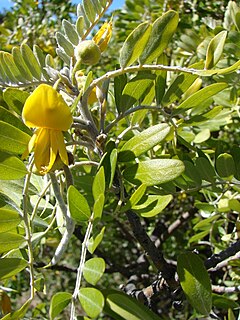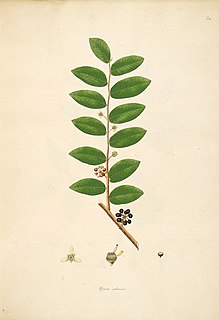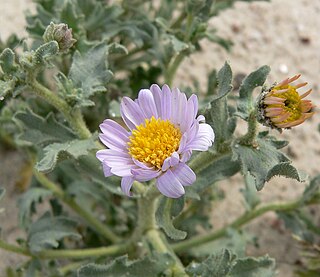
Mimosa is a genus of about 420 species of herbs and shrubs, in the mimosoid clade of the legume family Fabaceae. The generic name is derived from the Greek word μῖμος (mimos), an "actor" or "mime", and the feminine suffix -osa, "resembling", suggesting its 'sensitive leaves' which seem to 'mimic conscious life'.

Gaillardia is a genus of flowering plants in the family Asteraceae, native to North and South America. It was named after Maître Gaillard de Charentonneau, an 18th-century French magistrate who was an enthusiastic botanist. The common name may refer to the resemblance of the inflorescence to the brightly patterned blankets made by Native Americans, or to the ability of wild taxa to blanket the ground with colonies. Many cultivars have been bred for ornamental use.

The coal tit or cole tit,, is a small passerine bird in the tit family, Paridae. It is a widespread and common resident breeder in forests throughout the temperate to subtropical Palearctic, including North Africa. The black-crested tit is now usually included in this species.

Sophora is a genus of about 45 species of small trees and shrubs in the pea family Fabaceae. The species are native to southern Asia, Australasia, various Pacific islands, western South America, the western United States, Florida and Puerto Rico. The generic name is derived from sophera, an Arabic name for a pea-flowered tree.

Syzygium is a genus of flowering plants that belongs to the myrtle family, Myrtaceae. The genus comprises about 1200 species, and has a native range that extends from Africa and Madagascar through southern Asia east through the Pacific. Its highest levels of diversity occur from Malaysia to northeastern Australia, where many species are very poorly known and many more have not been described taxonomically.

Dermatophyllum is a genus of three or four species of shrubs and small trees in the subfamily Faboideae of the pea family, Fabaceae. The genus is native to southwestern North America from western Texas to New Mexico and Arizona in the United States, and south through Chihuahua, Coahuila and Nuevo León in northern Mexico. Members of the genus are commonly known as mescalbean, mescal bean or frijolito. One of the common names of Dermatophyllum secundiflorum is Texas mountain laurel, although the name mountain laurel also refers to the very dissimilar and unrelated genus Kalmia and the name laurel refers generally to plants in the unrelated order Laurales.

Acacia, commonly known as the wattles or acacias, is a large genus of shrubs and trees in the subfamily Mimosoideae of the pea family Fabaceae. Initially, it comprised a group of plant species native to Angola and Australasia. The genus name is New Latin, borrowed from the Greek ἀκακία, a term used by Dioscorides for a preparation extracted from the leaves and fruit pods of Vachellia nilotica, the original type of the genus. In his Pinax (1623), Gaspard Bauhin mentioned the Greek ἀκακία from Dioscorides as the origin of the Latin name.

Jinfengopteryx is a genus of maniraptoran dinosaur. It was found in the Qiaotou Member of the Huajiying Formation of Hebei Province, China, and is therefore of uncertain age. The Qiaotou Member may correlate with the more well-known Early Cretaceous Yixian Formation, and so probably dates to around 122 Ma ago.

Dromaeosaurinae is a subfamily of the theropod group Dromaeosauridae. The earliest dromaeosaurine is Utahraptor, dating back to the Early Cretaceous period in North America, however, some isolated teeth seems to represent an indeterminate species of dromaeosaurine, coming from the Late Jurassic period in Africa. If true, this will push their range to the Jurassic period, instead of the Cretaceous, as in most dromaeosaurs.

The Mutisioideae are a subfamily in the plant family Asteraceae that includes about 630 species assigned to 44 different genera. This subfamily is mainly native in South America, except for Adenocaulon, Chaptalia, Gerbera, Trichocline, which have species in all continents other than Europe and Antarctica. Common characters are the deeply incised corollas of the disc florets, with five lobes, sometimes merged in two lips, flower heads with overlapping involucral bracts, anthers with tails and pointy tips, the styles usually stick far out of the florets and are essentially hairless. Most species are herbs, but some are vines, shrubs, or small trees.

Polyalthia is a genus of flowering plants in the family Annonaceae. There are approximately 90 species distributed from Africa to Asia and the Pacific.

Perityle is a genus of flowering plants in the daisy family. They are known generally as rock daisies.

Arida is a genus of flowering plants in the daisy family, Asteraceae.

Xanthisma, common name sleepy-daisy, is a genus of flowering plants in the family Asteraceae.
Alepidocline is a genus of flowering plants in the famly Asteraceae described as a genus in 1934.

Tridax is a genus of flowering plants in the family Asteraceae.

Proustia is a genus of flowering plants in the family Asteraceae, native to South America and the West Indies.
Guy L. Nesom is an American writer and botanist.

The Nassauvieae are a tribe of flowering plants in the family Asteraceae.

This timeline of dromaeosaurid research is a chronological listing of events in the history of paleontology focused on the dromaeosaurids, a group of sickle-clawed, bird-like theropod dinosaurs including animals like Velociraptor. Since the Native Americans of Montana used the sediments of the Cloverly Formation to produce pigments, they may have encountered remains of the dromaeosaurid Deinonychus hundreds of years before these fossils came to the attention of formally trained scientists.

















